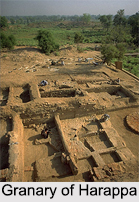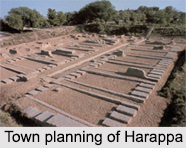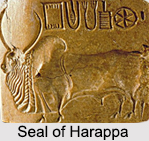 The greater Indus region was home to the largest of the 4 ancient urban civilizations of Egypt, Mesopotamia, South Asia and China. The city of Harappa in the Indus Valley Civilization flourished around 2600 to 1700 BCE in the western part of South Asia. The Harappa civilisation was spread over Afghanistan, Sind, Baluchistan, Jammu, Punjab, northern Rajasthan, Kathiawar and Gujarat. The Kalibangan?- Mohenjodaro represent the centre of the Harappan civilisation and most of the settlements of Harappa were located in this region.
The greater Indus region was home to the largest of the 4 ancient urban civilizations of Egypt, Mesopotamia, South Asia and China. The city of Harappa in the Indus Valley Civilization flourished around 2600 to 1700 BCE in the western part of South Asia. The Harappa civilisation was spread over Afghanistan, Sind, Baluchistan, Jammu, Punjab, northern Rajasthan, Kathiawar and Gujarat. The Kalibangan?- Mohenjodaro represent the centre of the Harappan civilisation and most of the settlements of Harappa were located in this region.
There were early and later cultures, known as Early Harappa and Later Harappa. The Harappan period characterised by seals, beads, weights, stone blades and baked bricks is called as the Mature Harappa culture. Rediscovered during the 1920s, the excavations at Harappa in west Punjab south of Lahore, it is said that the territory contains the ruins of an ancient fortified city from the Bronze Age.
Architecture of Harappa
Harappa was located near the Ravi River, which is a tributary of the upper Indus region. The patterns of settlements were based on the behaviour of rivers which is based around the flood plain ecology, regional trade over rivers, favourable climate for daily life, access to trade routes and natural resources etc. Easy access to water table near rivers and arable land due to alluvial soil encourages human habitation. The city of Harappa was divided into 2 or more parts with a citadel in west that comprised of granaries, religious buildings, public buildings, and assembly halls. The eastern side was comparatively larger but lower that the western zone and was called "the lower town" by archaeologists. The lower town was divided into rectangular sections cut by wide roads at right angles to each other. The city of Harappa also had a well-planned drainage system where every house had a drain connected to the street sewers which was further linked to a bigger sewer. The drains on the streets were also covered with stone slabs that were laid in straight lines along with inspection holes for the cleanup purposes.
Culture of Harappa
Having its earliest roots in cultures such as that of Mehrgarh, the Harappan civilization was mostly an urban culture maintained by additional agricultural production, trade and commerce. During the Early Harappan phase also known as the Integration Era, trade networks were established along with the domestication of crops. Peas, sesame seeds, dates, cotton, etc, were grown during that time. This era is characterized by centralized authority and an increasingly urban quality of life.
 Then came the Mature Harappan phase, when the concept was irrigation introduced along with urban planning. It was during this period that the people of Harappa evolved new techniques in metallurgy and produced copper, bronze, lead and tin. They also had the knowledge of proto-dentistry and the touchstone technique of gold testing. Trade became the main occupation during this era and the main forms of transport included bullock carts and boats. The pottery, seals, figurines, ornaments, etc of the civilization show great similarities with those of Central Asia and the Iranian plateau, indicating trade with them. There are also signs of maritime trade network between the Harappan and Mesopotamian civilizations.
Then came the Mature Harappan phase, when the concept was irrigation introduced along with urban planning. It was during this period that the people of Harappa evolved new techniques in metallurgy and produced copper, bronze, lead and tin. They also had the knowledge of proto-dentistry and the touchstone technique of gold testing. Trade became the main occupation during this era and the main forms of transport included bullock carts and boats. The pottery, seals, figurines, ornaments, etc of the civilization show great similarities with those of Central Asia and the Iranian plateau, indicating trade with them. There are also signs of maritime trade network between the Harappan and Mesopotamian civilizations.
During this Mature Harappan phase also known as the Localization Era, a large number of figurines have been found in the Indus Valley Civilization which suggests that the people of Harappa worshipped a Mother Goddess, who symbolized fertility. Some of the seals of that era also have the swastikas engraved on them. Then, there are few others in which a figure is seated in a yoga-like posture and is surrounded by animals. This figure is quite similar to that of Lord Pashupati, the Lord of Creatures.
It was during the Late Harappan phase or the Regionalization Era that the civilization started to decline and the cities were abandoned. The major reasons of the decline of the civilization are believed to be connected with climate change along with diseases. Paleopathological analysis has demonstrated that leprosy and tuberculosis were present at Harappa. Furthermore, rates of craniofacial trauma and infection increased through time demonstrating that the civilization collapsed amid illness and injury.
Economy of Harappa
 Harappan food economy was based on combination of agriculture, pastoralism, fishing and hunting. They farmed domesticated wheat, barley, pulses, millets, sesame, peas and other vegetables. Animal husbandry included humped and non-humped cattle like the infamous humped bull and to a lesser degree sheep and goats. The people also hunted elephant, rhinoceros, water buffalo, elk, deer, antelope and wild ass. The blood sport of cockfighting which was then known as "Fowl for Fighting" was also pretty common at that time.
Harappan food economy was based on combination of agriculture, pastoralism, fishing and hunting. They farmed domesticated wheat, barley, pulses, millets, sesame, peas and other vegetables. Animal husbandry included humped and non-humped cattle like the infamous humped bull and to a lesser degree sheep and goats. The people also hunted elephant, rhinoceros, water buffalo, elk, deer, antelope and wild ass. The blood sport of cockfighting which was then known as "Fowl for Fighting" was also pretty common at that time.
Crafts of Harappa
Further excavations at Harappa have yielded a prosperous group of objects in terracotta, stone and bronze. One of the most identified figurines is probably the Dancing Girl in bronze metal. The figure of Mother Goddess found from excavation is also an exemplary piece of craft form. The stone figures of torso in red sandstone and the other of a bust of a bearded man bear ample testimony to the exquisite art form of the civilization. The people also made rough terracotta statuettes of men and women. Furthermore, a terracotta mask of a horned deity has also been found after excavations. Other metals used were gold, silver and lead, out of which lead was employed occasionally for making small vases and such objects as plumb bobs. Silver is relatively more common than gold, and more than a few vessels are known, generally in forms similar to copper and bronze examples. Gold is by no means common and was generally reserved for such small objects as beads, pendants and brooches. The concept of pottery in the Harappan civilization was also quite common. The pottery of that period was one of a kind; the most striking ceramic piece is a heavy sturdy ware of superior fabric, pink or red in colour in the section and on surface. Stone, although largely absent from the great alluvial plain of the Indus, played a major role in Harappan material culture.
Archaeology of Harappa
The most exquisite and obscure artefacts unearthed from Harappa are the small, square steatite or soapstone seals engraved with human or animal motifs. These seals bear pictographic inscriptions generally thought to be a form of writing or script, which could not be deciphered after much effort by several philologists. Ever since its first excavation, the city of Harappa has had over 25 field sessions.
Although relatively little data has been found at Harappa as compared to other sites of the Indus Valley, it nonetheless holds the distinction of being considered the first identified site of the Indus Valley Civilization and hence is still a major site in terms of excavations.



















